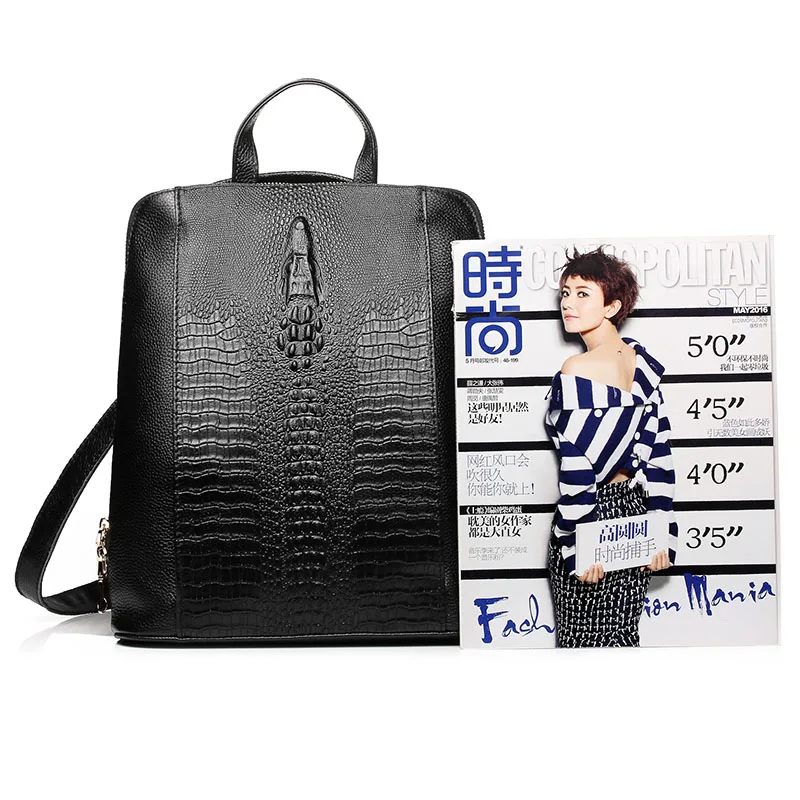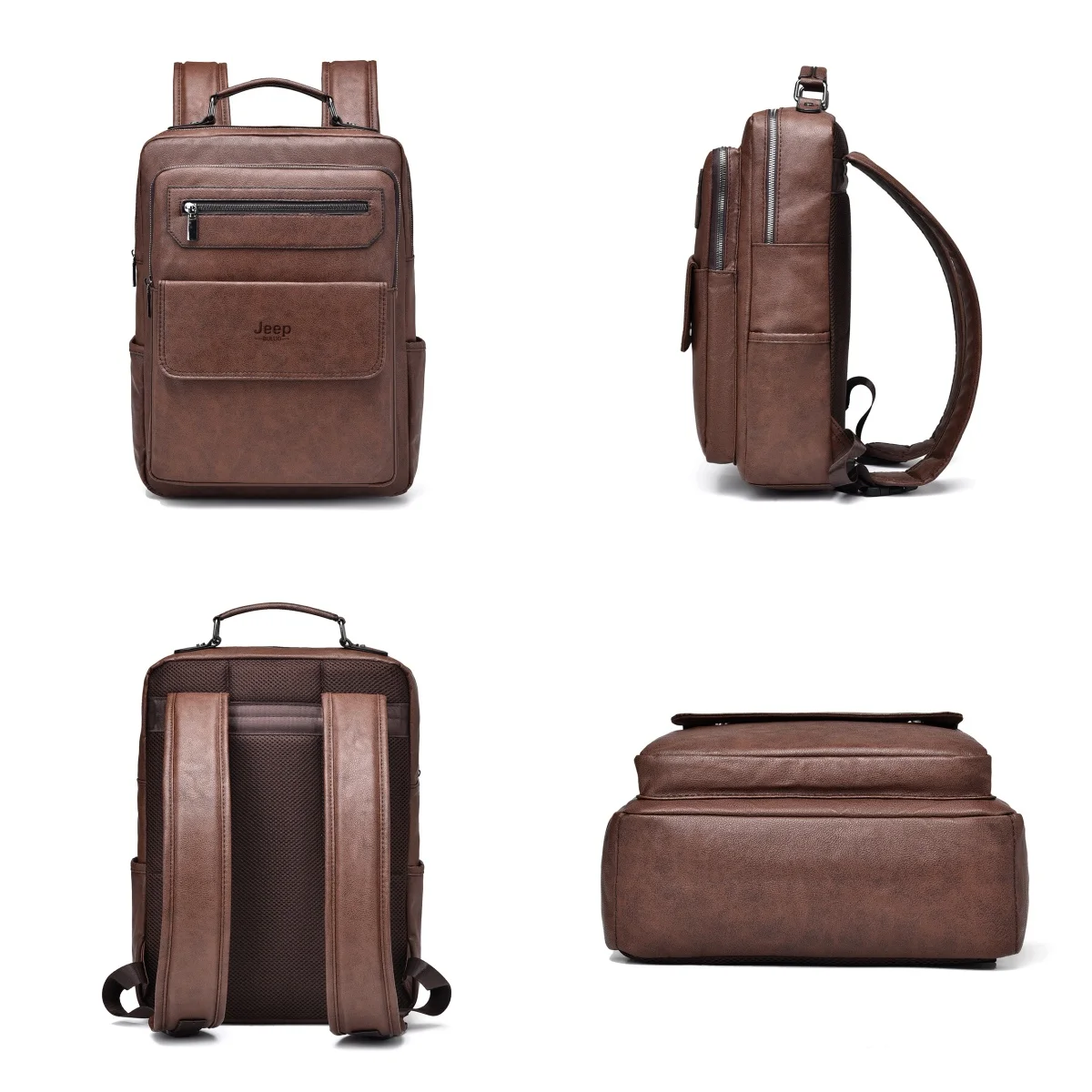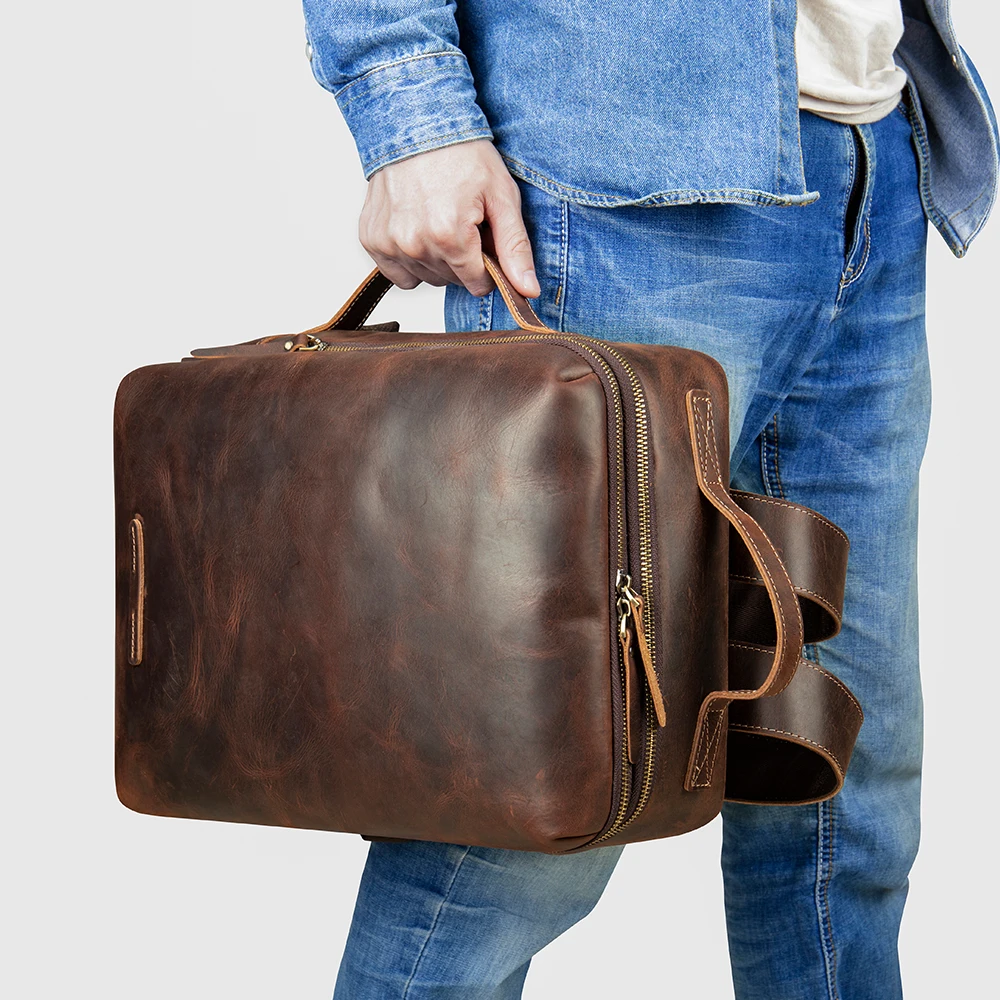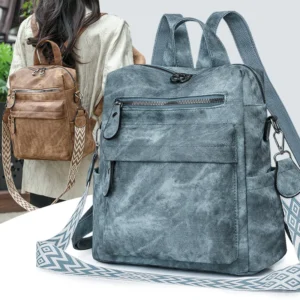Introduction: The Sustainable Revolution in Leather Goods
In recent years, a quiet revolution has been transforming the accessories we carry every day. As environmental consciousness grows, consumers are increasingly seeking products that align with their values—without sacrificing quality or style. Sustainable leather backpacks represent this perfect intersection of ethics and aesthetics.
These eco-conscious carriers are more than just bags; they’re statements of intent. Sustainable leather backpacks utilize environmentally responsible production methods, ethical sourcing, and craftsmanship designed to create products that last for decades rather than seasons. The market for these responsibly-produced items has seen remarkable growth, with sustainable leather goods showing a 24% increase in consumer interest over the past few years.
The benefits of choosing sustainable leather extend far beyond simple environmental impact. From reducing your carbon footprint to supporting ethical labor practices, from investing in exceptional durability to protecting your personal health—the advantages are multifaceted and significant. As you consider your next backpack purchase, understanding the leather conditioning and waterproofing techniques that maintain these products becomes equally important.
At Summit Carry, we’ve witnessed firsthand how premium full-grain leather backpacks crafted with sustainable practices not only meet but exceed consumer expectations for performance and longevity. Let’s explore the comprehensive benefits of making this conscious choice.
What Makes Leather Truly Sustainable? Understanding the Criteria
The term “sustainable leather” encompasses various approaches and standards rather than a single definition. To truly understand what makes a leather backpack sustainable, we need to examine several key criteria that distinguish these products from conventional alternatives.
Ethical sourcing forms the foundation of sustainable leather. This means using hides that are byproducts of the food industry rather than sourced specifically for leather production. Responsible animal husbandry practices ensure that animals are treated humanely during their lifetimes.
Eco-friendly tanning represents perhaps the most significant difference between conventional and sustainable leather. Traditional chrome tanning uses chromium sulfate and other chemicals that can be harmful to workers and the environment. By contrast, sustainable options include:
- Vegetable tanning using plant extracts like tree bark, leaves, and fruits
- Chrome-free mineral tanning that eliminates hexavalent chromium
- Low-impact hybrid tanning methods that reduce chemical usage
Resource efficiency throughout production is another hallmark of sustainable leather. This includes water conservation, energy efficiency, waste reduction, and proper treatment of effluent before it returns to waterways.
Perhaps most importantly, sustainable leather embraces circular design principles—creating products built for longevity, repair, and eventual biodegradability. This contrasts sharply with the “fast fashion” approach that dominates many accessories categories today.
Many luxury leather backpacks now incorporate these sustainable practices while maintaining premium quality. The result is a product that not only looks and feels exceptional but also carries significantly less environmental burden than conventional alternatives.
Environmental Advantages: How Sustainable Leather Reduces Ecological Impact
Waste Reduction
Sustainable leather production excels at turning potential waste into valuable resources. By utilizing hides that are byproducts of the meat industry, these practices prevent thousands of tons of organic material from entering landfills annually. This approach gives new purpose to materials that would otherwise be discarded.
Furthermore, sustainable leather production often incorporates leather scraps and offcuts into new products or smaller accessories, maximizing material usage. This closed-loop approach significantly reduces waste compared to conventional manufacturing that may discard imperfect sections.
Lower Chemical Impact
Traditional leather tanning typically involves chrome tanning, which uses chromium sulfate and other potentially harmful chemicals. Sustainable alternatives dramatically reduce this chemical footprint:
Vegetable tanning uses natural tannins extracted from plants, trees, and fruits instead of heavy metals and synthetic chemicals. This process produces wastewater with significantly fewer toxins—up to 80% less harmful runoff compared to conventional methods.
Water pollution decreases substantially when tanneries implement proper effluent treatment and closed-loop water systems. Some certified sustainable tanneries have reduced water contamination by over 90% compared to non-certified facilities in the same regions.
Biodegradability
Unlike synthetic alternatives that may persist in landfills for centuries, properly tanned sustainable leather will eventually biodegrade. Vegetable-tanned leather can decompose within decades rather than centuries, returning to the natural cycle instead of contributing to long-term waste accumulation.
This biodegradability also means that sustainable leather avoids the microplastic pollution associated with synthetic alternatives. As synthetic bags break down, they release microscopic plastic particles that contaminate water systems and enter the food chain.
Resource Efficiency
Certified sustainable tanneries typically employ advanced water and energy conservation methods. Some facilities have achieved water usage reductions of up to 40% compared to industry averages through water recycling and efficient processes.
Many sustainable leather producers have also transitioned to renewable energy sources and implemented energy-efficient equipment. This shift significantly reduces the carbon footprint associated with leather production.
Understanding proper waterproofing techniques for leather bags allows owners to maintain their items with minimal environmental impact. By choosing high-quality leather backpacks and maintaining them properly, consumers extend product life and further reduce their environmental footprint.
Ethical and Social Impact: The Human Side of Sustainable Leather
Beyond environmental considerations, sustainable leather production creates significant positive impacts for the people involved throughout the supply chain. This human dimension represents an often-overlooked but equally important aspect of sustainability.
Worker Welfare
Sustainable leather production prioritizes safe working environments with proper ventilation, protective equipment, and reduced exposure to harmful chemicals. Workers in certified facilities typically receive comprehensive training on safe handling procedures and emergency protocols.
Fair compensation represents another critical difference. While conventional leather production can involve exploitative wages in some regions, sustainable brands typically ensure living wages that support workers and their families. Some premium sustainable leather brands even partner directly with artisan cooperatives to ensure fair compensation.
Community Support
Many sustainable leather operations help preserve traditional craftsmanship that has been refined over generations. These skills might otherwise disappear in the face of mass production techniques, representing a loss of cultural heritage.
Communities surrounding sustainable tanneries benefit from reduced pollution and healthier environments. Some sustainable leather initiatives specifically target economic development in rural areas, creating stable employment where opportunities might otherwise be limited.
Supply Chain Transparency
True sustainability requires traceability throughout the production process. Reputable sustainable leather brands can typically identify exactly where their hides originate, which tanneries process them, and who crafts the final products. This transparency creates accountability that’s often absent in conventional leather production.
Animal Welfare Standards
Ethical sourcing ensures animals receive proper treatment during their lives. Many sustainable leather producers source exclusively from farms with documented animal welfare practices and regular independent auditing.
By using byproducts from the food industry rather than supporting leather-specific animal farming, sustainable leather makes efficient use of existing resources without driving additional demand for livestock production.
Durability and Longevity: The Investment Value of Sustainable Leather
Superior Longevity
Sustainable leather often demonstrates remarkable durability advantages over both conventional leather and synthetic alternatives. The natural tanning methods used in sustainable production frequently preserve the leather’s inherent strength better than harsh chemical processes that can degrade fiber structure.
With proper care, a high-quality sustainable leather backpack can easily last 10-15 years of regular use, while many synthetic alternatives might need replacement after just 2-3 years. This extended lifespan means fewer resources consumed over time and less waste generated.
Aging Beauty
Unlike many materials that deteriorate aesthetically with age, quality sustainable leather develops a unique patina that many users find more appealing than the original finish. This characteristic, especially evident in vegetable-tanned leather, means the product becomes more personally valuable over time rather than less.

This natural aging process creates a personal connection between the owner and the item, as the leather begins to reflect the owner’s lifestyle and usage patterns. Many sustainable leather enthusiasts appreciate how their vintage leather backpacks tell a story through their evolving appearance.
Economic Value Over Time
While sustainable leather backpacks typically carry a higher initial price tag, their cost-per-use often proves significantly lower than budget alternatives. A $300 sustainable leather backpack used regularly for 10 years costs just $30 per year of service—often less than replacing a $60 synthetic bag every two years.
Additionally, quality leather items typically retain value better than synthetic alternatives. Some well-maintained premium leather products can even become more valuable over time, especially from recognized brands with strong sustainability credentials.
Quality Construction
Sustainable leather products frequently feature superior construction methods like double stitching, reinforced stress points, and high-quality hardware. These construction details complement the material quality to ensure exceptional durability.
Understanding proper DIY leather care for travel backpacks helps owners maximize this longevity advantage. Simple maintenance routines can significantly extend the functional lifespan of sustainable leather products.
Health and Safety Benefits for Consumers
The benefits of sustainable leather extend beyond environmental and ethical considerations to include tangible health advantages for users. These advantages stem primarily from the reduction or elimination of potentially harmful chemicals throughout the production process.
Reduced Chemical Exposure
Conventional leather often contains residual processing chemicals, including chromium compounds, formaldehyde, azo dyes, and various finishing agents. Through direct skin contact or off-gassing, these chemicals can potentially cause irritation or more serious reactions in sensitive individuals.
Sustainable leather, particularly vegetable-tanned varieties, significantly reduces or eliminates many of these concerning substances. This reduction minimizes the potential for chemical transfer to skin during everyday use.
Hypoallergenic Properties
The natural tanning agents used in vegetable-tanned leather typically cause fewer allergic reactions than the chemicals used in conventional chrome tanning. This makes sustainable leather options potentially better choices for individuals with chemical sensitivities or certain skin conditions.
The absence of synthetic dyes and finishes in many sustainable leather products further reduces the likelihood of skin irritation for regular users. Instead of artificial colorants, many sustainable leather producers use plant-based dyes or simply allow the leather to develop its natural color through the tanning process.
Indoor Air Quality
Like many manufactured goods, newly produced leather items can release volatile organic compounds (VOCs) through a process called off-gassing. Sustainable leather typically contains fewer volatile chemicals, resulting in reduced off-gassing and better indoor air quality.
This benefit becomes particularly relevant for items kept in enclosed spaces like vehicles, offices, or bedrooms. The reduction in potentially irritating fumes contributes to healthier living and working environments.
How to Identify Genuinely Sustainable Leather Backpacks
With increasing consumer interest in sustainable products, the market has seen a rise in “greenwashing”—misleading claims about environmental benefits. Learning to identify truly sustainable leather backpacks helps ensure your purchase aligns with your values.
Key Certifications
The Leather Working Group (LWG) certification represents the industry’s most respected environmental standard. LWG audits tanneries and awards ratings (Gold, Silver, Bronze) based on environmental performance, chemical management, and traceability. Products using leather from LWG-certified tanneries generally have lower environmental impacts.
Other relevant certifications include:
* OEKO-TEX Standard 100 (verifies the absence of harmful substances)
* ZDHC (Zero Discharge of Hazardous Chemicals)
* Bluesign (ensures environmentally friendly and safe production)
These certifications provide independent verification of sustainability claims rather than relying solely on brand marketing.
Brand Transparency
Truly sustainable brands typically demonstrate transparency about their supply chain, material sourcing, and production processes. Look for detailed information about:
* Where and how their leather is sourced
* Which tanneries process their leather
* Manufacturing locations and labor standards
* Specific sustainability initiatives and measurable impacts
Red flags include vague terms like “eco-friendly” without specifics, absence of certification information, or inability to answer basic questions about sourcing and production.
Material Assessment
Quality sustainable leather typically has visible natural variations rather than perfectly uniform appearance. These natural markings indicate minimal processing and finishing, which generally correlates with lower environmental impact.
The leather’s smell provides another indicator—heavily processed leather often has a strong chemical odor, while vegetable-tanned sustainable leather typically has a more subtle, natural scent.
Understanding the benefits of sturdy leather backpacks helps consumers identify quality products that will stand the test of time. For those seeking sustainable options specifically for men, exploring dedicated men’s leather backpack collections can provide tailored solutions.
Construction Quality Indicators
Sustainable leather products generally focus on longevity through quality construction. Look for:
* Dense, even stitching with no loose threads
* Reinforcement at stress points
* Quality hardware (zippers, buckles, snaps) that operates smoothly
* Thoughtful design that allows for repair rather than replacement
These construction details support sustainability by extending the product’s usable life.
The Aesthetic Appeal: Style Meets Sustainability
Sustainability and style are not mutually exclusive—in fact, sustainable leather often offers unique aesthetic advantages that mass-produced alternatives cannot match.
Timeless Design Philosophy
Sustainable leather brands typically embrace timeless design principles rather than chasing seasonal trends. This approach creates products that remain stylish for decades, avoiding the aesthetic obsolescence that drives frequent replacements.
The classic silhouettes and thoughtful detailing of well-designed sustainable backpacks complement diverse personal styles while resisting the rapid cycles of fashion trends. This timelessness contributes to both the product’s longevity and its versatility.
Material Beauty
Sustainably produced leather often preserves more of the material’s natural characteristics. The visible grain patterns, subtle color variations, and unique markings tell a story about the material’s origin that homogenized products cannot match.

Vegetable-tanned leather in particular offers rich, complex colors that develop depth over time. Unlike the flat, uniform appearance of heavily processed materials, sustainable leather has visual dimension and character that many users find inherently appealing.
Patina Development
Perhaps the most distinctive aesthetic quality of sustainable leather is how it evolves through use. The material develops a patina—a surface character that reflects its history and handling. This evolutionary quality means the backpack becomes more uniquely yours over time.
14 Inch Leather Laptop Backpack, Brown Leather Backpack, Men's Leather Backpack, Vintage Leather Backpack
Price range: $177.28 through $199.12 Select options This product has multiple variants. The options may be chosen on the product pageCarry On Leather Backpack, Roll Top Leather Backpack
Price range: $77.76 through $96.48 Select options This product has multiple variants. The options may be chosen on the product pageDesigner Mini Backpack, Mini Leather Backpack, Small Leather Sling Backpack, Women's Leather Backpack
Price range: $95.76 through $98.80 Select options This product has multiple variants. The options may be chosen on the product pageDesigner Mini Backpack, Designer Women's Backpack, Mini Leather Backpack, Women's Leather Backpack
Price range: $135.92 through $137.64 Select options This product has multiple variants. The options may be chosen on the product pageBlack Leather Backpack, Small Leather Backpack, Women's Leather Backpack
Price range: $112.96 through $116.12 Select options This product has multiple variants. The options may be chosen on the product page- Price range: $80.72 through $108.04 Select options This product has multiple variants. The options may be chosen on the product page
The patina serves as a visual record of your journeys together, with subtle color shifts, softening of the leather, and a gentle sheen that develops through handling. Many sustainable leather enthusiasts consider this living quality to be the material’s most appealing characteristic.
Caring for Sustainable Leather: Maximizing Longevity
Proper maintenance plays a crucial role in maximizing the benefits of sustainable leather backpacks. With appropriate care, these products can remain functional and beautiful for many years, further enhancing their sustainability credentials.
Proper Maintenance Practices
Regular cleaning with a soft, dry cloth removes surface dust and prevents buildup that can damage the leather over time. For deeper cleaning, slightly dampened cloths or specially formulated leather cleaners appropriate for your specific tanning type work best.
Conditioning is essential for maintaining leather’s flexibility and moisture balance. Natural conditioners like beeswax, neatsfoot oil, or specialized plant-based formulations help nourish the leather without introducing harmful chemicals. Apply sparingly every 3-6 months, depending on usage and climate conditions.
Understanding leather maintenance for commuters is particularly important for those who use their backpacks daily in varying conditions.
Storage Guidelines
Store leather backpacks in cool, dry environments away from direct sunlight, which can fade and dry the leather. When not in use for extended periods, stuff the backpack lightly with acid-free paper to help maintain its shape.
Avoid plastic storage covers, which can trap moisture and lead to mildew. Instead, use breathable cotton bags if dust protection is needed during storage.
Repair Possibilities
Quality leather backpacks are typically designed for repair rather than replacement. Minor issues like loose stitching, worn edges, or damaged hardware can often be fixed by skilled leather workers, extending the product’s life significantly.
Some premium leather brands offer repair services for their products, reinforcing their commitment to longevity. For vintage pieces or items from brands without repair programs, independent leather repair specialists can often restore functionality.
Frequently Asked Questions About Sustainable Leather Backpacks
Is all leather sustainable?
No, not all leather is sustainable. Conventional leather production often involves intensive chemical processes, high water usage, and questionable labor practices. Sustainable leather specifically addresses these issues through responsible sourcing, eco-friendly tanning methods, and ethical manufacturing standards. Look for specific sustainability certifications rather than assuming all leather products are environmentally friendly.
What is vegetable-tanned leather?
Vegetable-tanned leather is processed using tannins naturally found in plant materials like tree bark, leaves, fruits, and roots. This ancient method avoids the chromium salts and other harsh chemicals used in conventional tanning. The process takes longer (weeks versus days for chrome tanning) and creates leather with distinctive characteristics: it develops a rich patina, ages beautifully, and biodegrades more readily at the end of its life.
Can vegetable-tanned leather get wet?
Yes, vegetable-tanned leather can get wet, but it requires proper care afterward. Unlike chrome-tanned leather, which has some inherent water resistance, vegetable-tanned leather absorbs water more readily. If your vegetable-tanned backpack gets wet, gently blot (don’t rub) with a soft cloth, stuff with paper to maintain shape, and allow it to dry naturally away from direct heat. Once dry, apply an appropriate conditioner to restore moisture balance.
What types of sustainable leather exist?
Several types of sustainable leather exist, each with different environmental profiles:
* Vegetable-tanned leather using plant extracts
* Chrome-free mineral-tanned leather
* Recycled/upcycled leather made from production scraps
* Bio-based leathers combining leather fibers with plant materials
* Leather from certified regenerative agriculture sources
Each type offers different aesthetic and performance characteristics while addressing specific sustainability concerns.
How does sustainable leather compare to vegan alternatives?
This comparison is complex. Quality sustainable leather typically lasts longer than most synthetic vegan alternatives, potentially resulting in less waste over time. However, vegan alternatives avoid animal products entirely, which aligns with specific ethical concerns.
From an environmental perspective, many synthetic vegan alternatives are petroleum-based and may shed microplastics throughout their life cycle. Newer plant-based vegan leathers offer promising alternatives but may still involve significant processing and chemical treatments.
The most sustainable choice depends on your specific values, intended use, and how long you’ll keep the product.
Making the Sustainable Choice: Environmental Impact of Your Purchase Decision
The backpack you choose carries more than just your daily essentials—it carries a statement about your values and priorities. Each purchase decision represents a vote for the kind of world you want to support.
When you select a sustainable leather backpack, you contribute to a growing market shift toward responsible production methods. This consumer power has already influenced many brands to improve their environmental practices, demonstrating how individual choices collectively drive industry-wide change.
The impact extends beyond the product itself to affect broader manufacturing trends. As demand for sustainable leather grows, more tanneries invest in cleaner technologies, more brands prioritize ethical labor practices, and more consumers learn about the importance of buying fewer, better things.

There’s also a profound satisfaction in aligning your purchasing decisions with your personal values. Whether your primary concern is environmental impact, ethical production, or simply owning beautiful products that stand the test of time, sustainable leather backpacks offer a compelling option. For those seeking options specifically designed for women, exploring women’s leather backpack collections provides sustainable choices with feminine design elements.
By choosing quality over quantity and durability over disposability, you participate in a more thoughtful approach to consumption—one that values craftsmanship, respects natural resources, and recognizes that what we carry with us matters, in more ways than one.







